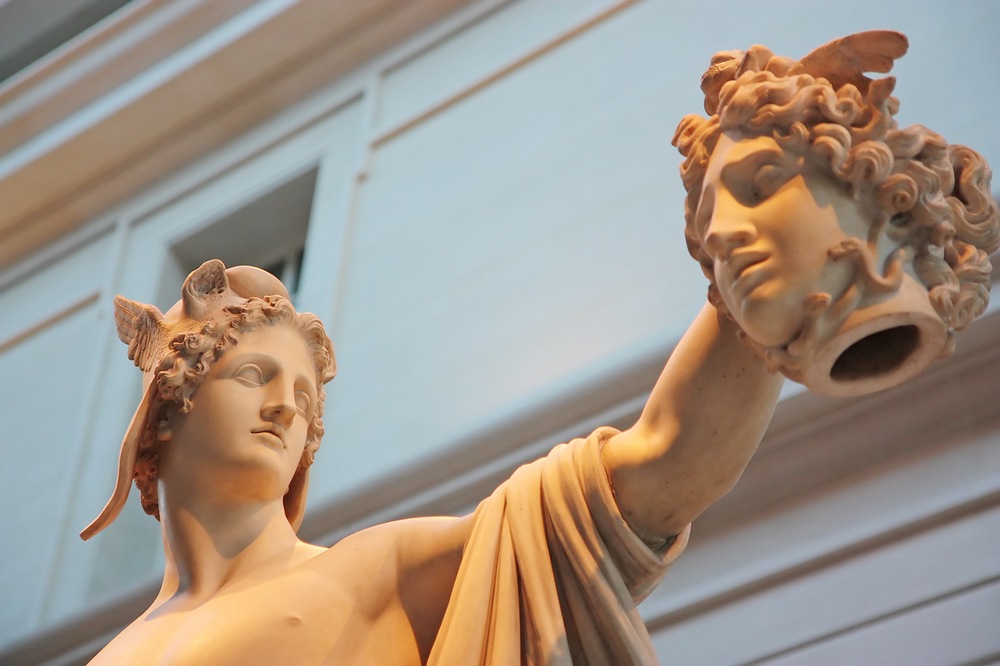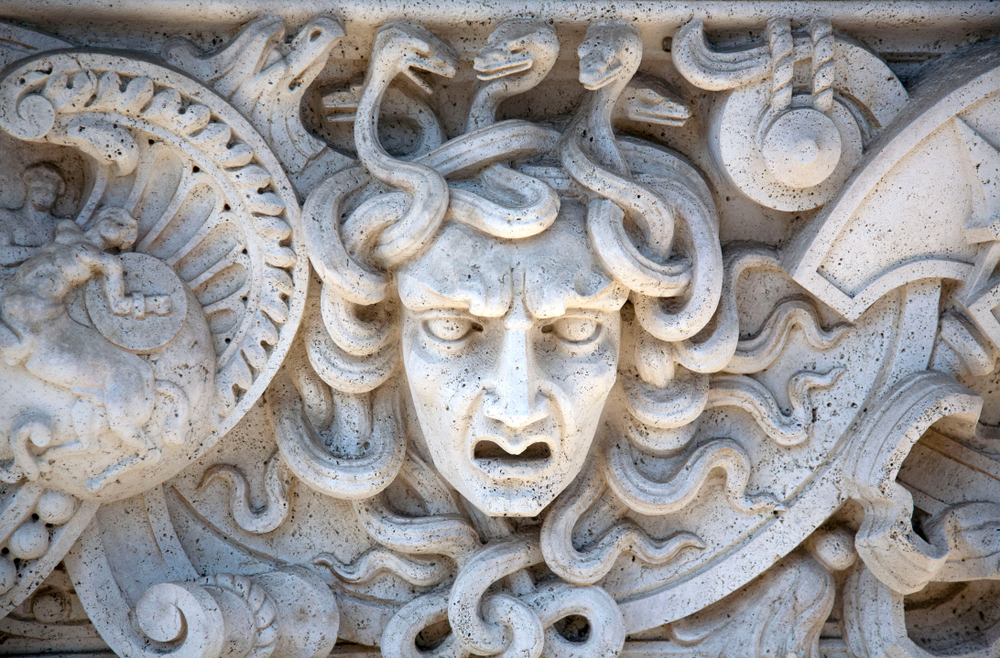Among the fascinating tales in Greek Mythology, the story of Medusa stands out, blending elements of mystery, fear, and tragedy. Let’s explore Medusa’s story, from her origins and transformation to her eventual demise, and how this narrative has been interpreted and retold over the centuries.
Jump to:
Who Was Medusa?

Medusa, often depicted with serpents for hair and the power to turn onlookers into stone, is one of Greek mythology's most famous figures. Her story, from its beginnings to its dramatic end at the hands of the hero Perseus, continues to fascinate and inspire discussions on the nature of victimhood, power, and the divine interplay in mortal lives.
The Story of Medusa

Medusa's tale is one of beauty turned to horror. Originally, she was a beautiful maiden with enviable locks. However, her life took a tragic turn following an encounter with Poseidon in Athena's temple. This event marked the beginning of her curse and transformation into one of Greek mythology's most recognisable and misunderstood figures.
Medusa Before the Curse: A Ravishing Maiden
Medusa began as a breathtakingly beautiful maiden, whose locks were the envy of all who beheld her. Known for her beauty across the land, Medusa's life was filled with admiration and attention, setting the stage for the tragic turn her fate would soon take.
The Fateful Encounter: Poseidon in Athena's Temple
The turning point in Medusa's life came with her encounter with Poseidon, the god of the sea, within the sacred confines of Athena’s temple. Attracted by Medusa's beauty, Poseidon pursued her. Medusa sought refuge in Athena's temple, hoping for protection. However, Poseidon disregarded the temple's sanctity and assaulted Medusa within its walls.
The Curse of Athena: Transformation and Punishment
Rather than directing her wrath at Poseidon, Athena punished Medusa, one of her priestesses who had taken a vow of celibacy. This curse transformed her into a creature with serpents for hair and a gaze that turned onlookers to stone. The reasons behind Athena's curse are layered, with interpretations ranging from divine punishment for desecrating her temple to an act of protection against further harm. This transformation marks a shift in Medusa's story from one of admiration to one of fear and misunderstanding.
Isolation and Tragedy
With the curse, Medusa's life turned to isolation and tragedy. No longer the object of admiration but of fear, her existence became a symbol of the complex interplay between beauty, power, and victimisation.
The Arrival of Perseus
Perseus’s quest to kill Medusa was a mission assigned to him as part of a larger narrative of heroism and divine intervention. Tasked with bringing back her head to save his mother from a forced marriage, Perseus's journey to Medusa's lair was encouraged by gifts from the gods: winged sandals from Hermes, a reflective shield from Athena, a sword from Hephaestus, and Hades's invisibility powers.
The Battle and Medusa’s Demise
Using the reflective shield to avoid Medusa’s direct gaze, Perseus approached the Gorgon while she slept. In a swift, decisive movement, he used the sword to behead Medusa, thus ending her life. This act required a strategic approach, exploiting Medusa's vulnerability to achieve victory.
Even in death, Medusa's power did not wane. Her head, now severed from her body, retained its petrifying gaze. Perseus used it as a weapon several times before ultimately giving it to Athena, who placed it on her shield, the Aegis. This transformation of Medusa from a being of terror to a symbol of protection underscores the complex nature of her legacy.
Medusa’s Legacy

In death, Medusa leaves an indelible mark on art, literature, and contemporary culture. Her legacy symbolised intrigue, resilience, transformation, and feminism.
Medusa in Art
The image of Medusa, particularly her head, has captivated artists for centuries, becoming a subject of fascination and reinterpretation across various mediums. From the ancient sculptures that adorned temples and shields, invoking her protective power to ward off evil, to the Renaissance masterpieces like Caravaggio's "Medusa," which captures the horror and mesmerising allure of her gaze, the representation of Medusa in art is broad. In contemporary times, Medusa continues to inspire artists, serving as a powerful symbol of transformation, challenging societal norms, and confronting the viewer with the complexity of her story.
Medusa in Literature
Literature has also played a role in sharing the myth of Medusa, with poets and writers delving into the layers of her story to explore themes of beauty, power, and victimisation. From Ovid's "Metamorphoses," which provides a descriptive account of Medusa's transformation, to modern works that seek to reclaim her narrative, offering perspectives that highlight her victimhood and resilience, Medusa remains a compelling figure whose story resonates with questions of identity, justice, and the power of the gaze.
Medusa in the Modern World
Medusa's story has found new relevance in today's cultural landscape, becoming a symbol for movements that challenge oppression and advocate for women's rights. Her image is invoked in discussions about the male gaze, victim-blaming, and the reclaiming of power by those who have been marginalised. Medusa tattoos, for instance, have emerged as a popular means of embodying the strength, transformation, and defiance that her story represents.
Statues and Sculptures
The fascination with Medusa has also been immortalised in statues and sculptures worldwide. From the ancient "Perseus with the Head of Medusa" by Benvenuto Cellini, which depicts the triumphant hero holding Medusa’s severed head, to modern installations that reinterpret her image to evoke empathy and reflection, these works invite viewers to confront the complexities of her myth. The statues stand as reminders of the enduring power of myth to inspire, challenge, and provoke.
Frequently Asked Questions About Medusa
Was Medusa Always Evil?
Contrary to some retellings, Medusa was not always the monster she became. Initially, she was a victim of the gods’ whims, and her story is a testament to the capricious nature of divine power in Greek mythology. Medusa's transformation raises questions about innocence and punishment, victim and aggressor.
What Does Medusa Symbolise in Greek Mythology?
In Greek mythology, Medusa symbolises many things, from the destructive power of rage and vengeance to the complexities of beauty and terror. She also represents physical and symbolic transformation as her story touches on themes of victimisation, power dynamics, and the gaze. Medusa's dual nature as victim and villain complicates her narrative, making her an enduring symbol of resilience and the potential for multiple interpretations.
Why is Medusa Often Misunderstood in Mythology?
Medusa is often misunderstood due to the varying accounts of her myth, the emphasis on her monstrous form over her origins, and the circumstances leading to her transformation. Early myths did not uniformly portray her as evil; rather, they highlighted her victimhood at the hands of the gods. Over time, the focus shifted towards her as a creature to be conquered, overshadowing her tragic backstory and the nuances of her character.
Can Medusa Be Considered a Feminist Symbol?
In contemporary discussions, Medusa has been reclaimed as a feminist symbol, representing female rage, resistance, and empowerment. Her image and story have been interpreted as metaphors for the male gaze, sexual violence, and the reclaiming of agency. This reinterpretation of Medusa reflects a broader cultural shift towards examining classical myths through modern lenses, highlighting issues of gender, power, and identity.
Was There Any Redemption for Medusa in Greek Mythology?
The traditional myths offer no redemption for Medusa; her story ends with her death at the hands of Perseus. However, in some modern interpretations and retellings, Medusa is given a form of redemption through the reevaluation of her story, focusing on her victimhood and resilience.
Who Were Medusa's Sisters, and Did They Share Her Fate?
Medusa had two sisters, Stheno and Euryale, who were also Gorgons. Unlike Medusa, they were immortal and did not share her fate. The myths describe them as equally fearsome but do not provide as detailed a narrative for them as for Medusa. Their role in the mythology is often overshadowed by Medusa's story, but they remain part of the Gorgon legend, embodying the terrifying power associated with their kind.
What Happened to Medusa's Children?
According to some versions of the myth, Medusa was pregnant by Poseidon at the time of her death, and from her severed neck sprang Pegasus, the winged horse, and Chrysaor, a giant wielding a golden sword. These offspring symbolise the mingling of horror and wonder, further complicating Medusa's legacy and underscoring the theme of life springing from death.
How Has Medusa's Image Evolved Over Time?
Medusa's image has evolved significantly, from a fearsome monster to a complex symbol of various contemporary issues. In art and literature, her depiction has shifted from focusing on her monstrous aspects to more nuanced portrayals exploring her tragedy, power, and symbolism. Today, Medusa continues to inspire artists, writers, and activists, reflecting her ongoing relevance and the multifaceted nature of her myth.
Recommended for you!
Best SellersDiscover Greek Mythology with Centre of Excellence
Begin an epic journey through ancient tales with our Greek Mythology Diploma Course, crafted to bring the rich narratives of gods, heroes, and monsters to life.
Why Centre of Excellence?
- Accessibility: We believe in making education accessible to all, so our courses are priced to welcome everyone interested in expanding their knowledge.
- Flexibility: Our courses are designed with your lifestyle in mind, offering the freedom to learn at your own pace and fit your studies seamlessly into your existing schedule.
- Variety of Topics: From the depths of Hades to the heights of Olympus, our curriculum explores a wide range of stories and themes, catering to all who are fascinated by the ancient myths that have shaped our world.
- Dedicated Support: Enrolment comes with personalised support from tutors and the chance to connect with a community of like-minded learners, providing a solid foundation of support throughout your educational journey.
Exclusive Offer:
We're excited to offer our Greek Mythology Diploma Course at the exceptional price of £29, offering savings of over £100!












